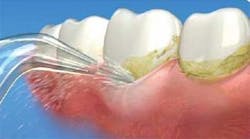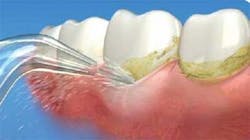The water jet's battle against an old foe
by Carol Jahn, RDH
One of the greatest pains to human nature is the pain of a new idea. It ... makes you think that after all, your favorite notions may be wrong, your firmest beliefs ill-founded.
— Walter Bagehot
Hours are spent cleaning plaque off of teeth and out of pockets, as well as instructing patients on how to remove it at home.An entire plaque-fighting arsenal exists — from scalers and polishers to toothbrushes and floss. Dire consequences — ranging from periodontal disease to caries to oral malodor — are predicted for those who don't remove it well.
Beliefs about plaque have shifted over the years. Back in the 1960s, there was the nonspecific plaque hypothesis. This philosophy implied that the greater amount of plaque, the more disease should be present. The theory was refuted as clinicians observed patients with heavy plaque and little disease, as well as those with minimal plaque and deep pockets. Thus, the specific plaque hypothesis was born with a focus on the type of bacteria present in the plaque regardless of the amount being causative for disease.
Over the last several years, the concept of plaque has experienced another transformation from the idea of a sticky matrix to a thriving, dynamic, microbial community called biofilm. It might be easy to simply think of biofilm as just another name for plaque. However, the concept of plaque as biofilm has uncovered new information about the structure, habitat, and survival of microbial species of plaque, as well as its contribution to disease virulence and microbial resistance.
Removing the plaque biofilm
Mechanical disruption via scaling is one of the most effective ways to disrupt biofilm. It provides the best argument to date for why patients in periodontal maintenance should return every three months. Scaling isn't the mere elimination of bacteria; re-formation begins within hours of the procedure. What scaling seems to do is change the type of bacteria present to one more compatible with health rather than disease.
The greater problem lies in everyday disruption of the plaque biofilm. Meticulous daily supragingival plaque biofilm control has been shown to affect the amount and composition of subingingival biofilm. It can be challenging for patients with periodontal pockets, implants, crown and bridge, orthodontic appliances, or any difficult to access area to use dental floss on a daily basis.
Toothbrushing is the most common and often only means of daily self-care used by most people. Interdental cleaning is necessary for optimal oral health; but flossing compliance is low. Other alternatives are available, such as toothpicks, wood points, interdental brushes, rinsing, and the dental water jet. Most of these provide limited access beyond 2 to 3 mm (see table).
Figure 2: Tooth treated with dental water jet for three-second pulsating lavage at medium pressure.
One exception is the pulsating dental water jet. Studies show that pulsation can disrupt bacteria up to 6 mm subgingivally.1,2 Yet some practitioners still believe that it does not remove plaque and are hesitant to recommend it to patients. It is surprising for some that studies3,4 dating back to the early 1970s demonstrated a significant reduction in plaque, and this trend has continued most recently in studies demonstrating the dental water jet as an effective alternative to dental floss.5,6
A 2009 study at the University of Southern California with biofilm expert Dr. Bill Costerton now provides visual definitive evidence that the Waterpik® dental water jet significantly removes plaque. By viewing teeth under a highly sensitive scanning electron microscope, the researchers were able to see far more than one could with the naked eye. The microscope revealed that a three-second pulsating lavage at medium pressure with a regular jet tip removed 99.9% of the plaque biofilm7 (see Figures 1 and 2).
The way plaque is viewed has evolved over the years as technology changes and improves. This same technology is now providing a new understanding about the capabilities of a pulsating dental water jet. With this new knowledge, coupled with over 50 already existing clinical studies, it is time to look at the dental water jet as a first choice to supplement toothbrushing. Whether the patient is using a power or manual toothbrush, adding the dental water jet can help decrease plaque, bleeding and gingivitis.5
References
- Cobb CM, Rodgers RL, Killoy WJ. Ultrastructural examination of human periodontal pockets following the use of an oral irrigation device in vivo. J Periodontol, 1988; 5(3)9:155-63.
- Drisko CL, White CL, Killoy WJ, Mayberry II WE. Comparison of dark-field microscopy and a flagella stain for monitoring the effect of a Water Pik on bacterial motility. J Periodontol, 1987; 5(6)8:381-86.
- Hoover DR, Robinson HBG. The comparative effectiveness of a pulsating oral irrigator as an adjunct in maintaining oral health. J Periodontol, 1971; 42(1):37-39.
- Phelps-Sandall BA, Oxford SJ. Effectiveness of oral hygiene techniques on plaque and gingivitis in patients placed in intermaxillary fixation. Oral Surg Oral Med Oral Path 1983; 56(5):487-90.
- Barnes CM, Russell CM, Reinhardt RA, Payne JB, Lyle DM. Comparison of irrigation to floss as an adjunct to toothbrushing: effect on bleeding, gingivitis and supragingival plaque. J Clin Dent 2005;16(3):71-77.
- Sharma NC, Lyle M, Qaquish JG, Galustians J, Schuller R.The effect of a dental water jet with orthodontic tip on plaque and bleeding in adolescent patients with fixed orthodontic appliances. Am J Orthod Dentofacial Orthop 2008, 133;(4):565-571.
- Gorur A, Lyle DM, Schaudinn C, Costerton JW. Biofilm removal with a dental water jet. Compend Contin Dent Ed 2009; 30(Spec Issue 1)1-6.









